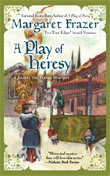CHAPTER 11
With Piers full of delight at showing off his skills and surprisingly patient at helping the other boys begin to learn simple tumbling, Joliffe had an easier time with the pack of them than he had feared he would. Whatever Piers had been doing these days of running wild in the town, he had plainly found an acknowledged place among these boys that made them willing to listen to him and follow his lead. Of course the thought of anyone following Piers’ lead in anything was usually cause for alarum, but Joliffe was not about the scorn the present usefulness of it…
In A Play of Heresy there’s much talk about merchants traveling back and forth between Coventry and Bristol, with mention made of the iron and wool that come into Coventry as raw materials and later sent out as completed goods. What some readers may find surprising — given the prevalent notion that medieval people did not travel far from home (the exceptions of course being to go on crusade or pilgrimage, or forming a mob to march on London) — is just how widely medieval people travelled in the ordinary way of things.
In England by late medieval times, serfdom was well on the wane due to economic changes at the manorial level, and by way of people named such things as John of Bywater and Joan of Ramsey turning up hired in towns a goodly distance from their apparent birthplace, we know there was significant shifting of individuals about the landscape and that people did not necessarily stay within a few miles of their village for all their lives.
Among those who most surely travelled farthest and widest were the merchants – the heart of the rising middle class of their day – and with them, not incidentally, would go their servants, taking advantage of an elaborate network of trade routes spread the length and breadth of England and stretching well overseas. Within England, there was a constant movement of native products: iron and other metals and the finished products made from them; wool to weaving centers from which the finished cloth went Europe-wide; slates from Wales to roof houses in London; coals from the North to heat homes in the south (air pollution from coal fires are noted in London in the 1480s); cattle on the hoof by drove roads from the grazing uplands in far corners of Britain to towns and cities where they could be sold for a profit. And so on.
And then from the ports, goods and merchants constantly came and went, ranging north to Iceland and the Scandinavian countries and into the Baltic, east to Flanders and France, southward along the Iberian coasts, with hope of eventually breaking the Italian control of the Mediterrean trade. A fascinating work that details this international trade from the English perspective is The Libelle of Englyshe Polycye – The Little Book of English Policy – written about 1436 and happily to be read online, should you wish to see into what a wide network of international trade the mercers and drapers and other merchants of Coventry were actually bound.
– Margaret
Follow the virtual bookclub for A Play of Heresy on Facebook and Twitter.
















